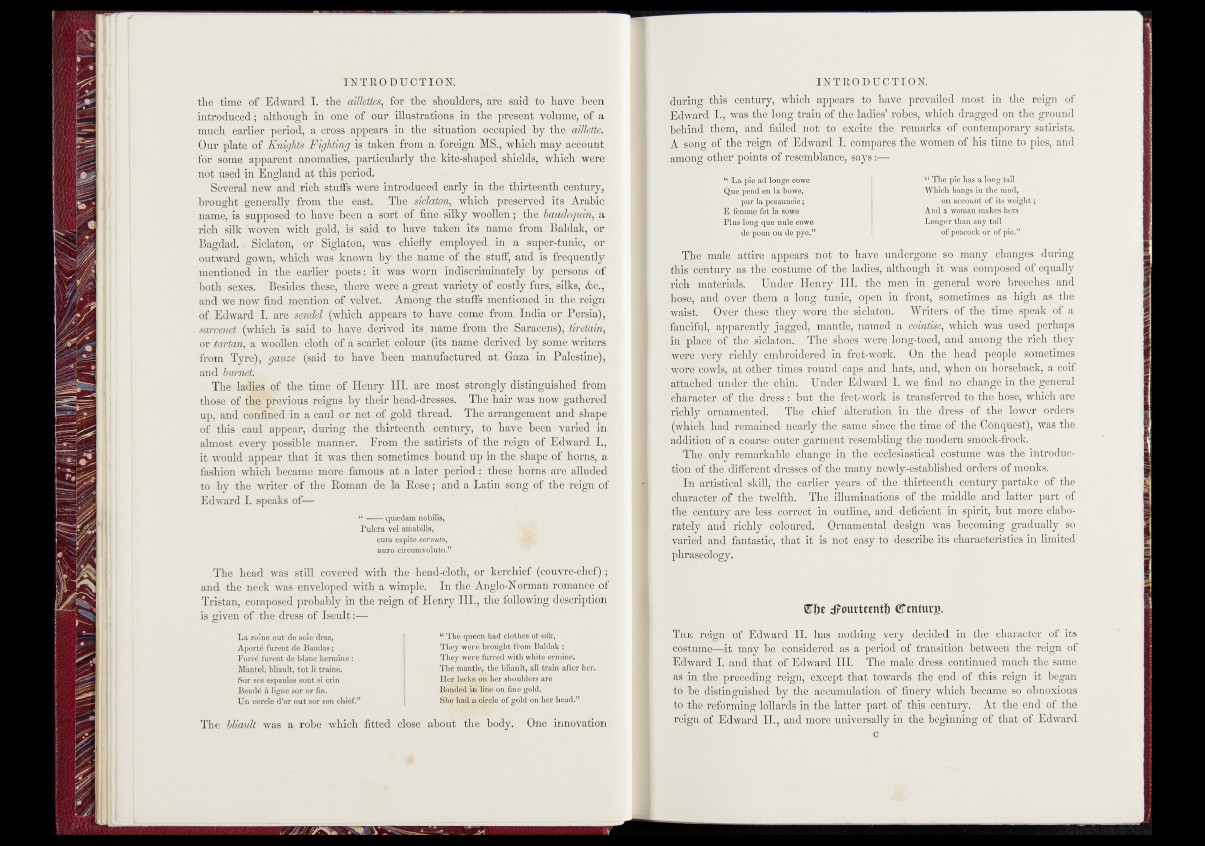
the time of Edward I. the aiUettes, for the shoulders,, are said to have hbift
introduced ; although in one of our illustrations in the present volume, of a
much earlier period, a cross-appears in the situation occupied by the aillette.
Our plate of Knights FigMiiig -is taken from a foreign MS., which may account
for some apparent anomalies,, particularly the kite-shaped shields, which were
not used in England at this period.
Several new and rich stuffs were introduced early in the thirteenth century,
brought .generally from the east. The siclaton, which preserved its Arabic
name, is supposed to have been a sort of fine silky woollen; the baudequin, a
rich silk woven with gold, is said to have taken its name from Baidak, or
Bagdad. & Siclaton, or- Siglaton, was chiefly employed, in a super-tunic,, of
outward gown, which was known by the name of the stuff, and is frequently
mentioned in the earlier poets: it'was worn indiscriminately by persons of
both sexes. Besides these, there were a great'variety of' costly"furs, silks, '&ci,-
and we now find mention of velvet. Among the stuffs mentioned in .-the reign
of Edward i.: are sendel (which appears to have come from India or Fersia)y;
sarcmet (which is said to have derived its name from the Saracens), tiretain,
or tartan, a woollen doth of a scarlet colour (its name derived, by some writers
from Tyre), gauze (said to have been manufactured at Gaza in Palestine)^
and bumet. .
tv The ladies of the time of Henry III. are. most strongly distinguished from
those Of thePprevious reigns by their head-dresses. The hair *ras now7gather,ed
up, and confined in a caul or net of gold thread. .The arrangement and. shape"
of this caul appear, during the thirteenth century, to have;'been varied Tn
almost every possible manner. From, the satirists of „the reign- of Edward I.,
it would appear that it was then sometimes bound up in the shape of horns,, a
fashion which became more famous at a later period : these horns are alluded
to by the writer of the Roman de la Rose; and a Latin song Of'Wtr-reign of
Edward I. speaks of-r—
- ’ “ —— qua-dam nobilis, .
Fulcra yel amabijis, -
„ cum capite cornutn, v :
auro circuJnvoluto.”
The head was still covered with the head-cloth, or kerchief (couyre-chef);
and the neck was enveloped with a wimple. In the Anglo-Norman romance of
Tristan, composed probably in the reign of Henry III., the following description
is given of the dress of Iseult:—
La roine out de soie dras,
Aporté furent de Baudas ;
Foiré furent de blanc bermine :
Mante], bliault, tôt li traîne.
Sor ses espaulea sont si crin -
Bendé à ligne sor or fin.
tjn cercle d’or out sor son chief.”
“ The queen bad clothes of silk,
They were brought from Baidak;
They were furred with white ermine.
The man^le-thei bliault, all-train after her.
Her locks on her shoulders are
Banded in line- on fine gold.
She had a circlo of gold on her head.” .
The bliault was a robe -which fitted close about the body. One innovation
during this century, which appears to; have prevailed most in the reign of
Edward I., was the long train of the-ladies’ robes, which dragged on the ground
behind them, and failed not ;to excite the remarks of contemporary satirists.
Ay song of the reign of Edward" I. compares the women of his time to pies, and
among other points of resemblance,1* says:—
M La pie ad longe cowe
“Que’pend en-la bo-te,
pur la pesauncie ;
E femme fet la sowe
Plus long qjie nule cowe
1 ‘ de jsoun ou de pye.”
,! The pie has a long tail
Which hangs in the mud,
. on account of its weight;
And a woman makes hers
Longer than any tail
of peacock or of pie.”.
The male attiré appears Im ^ o have»u|i.dergopb;('ldlniany changes during
this century as the-- costume . the ladies, -al^pi)ih';-ï|; was composed of equally
rich ;*materials. Under Henry III. | | | | maemÿhn general wore breeches and
hose, and over thém- a long,. tfml^ppenj i^^ra^yyhofli^iitû.^ as high as the
waist. • Over these tf^l,-wore-the ^iclaton. Writers'of „the time speak of a
fapciful, apparently jagged, mantle, named,.e^}yY^c,^w|^i;was used perhaps
in Mace of the siclatoM; j 'f h e * '^ ^ werevl^jfip®(fipd among the rich they
were ffery richly embroidered in frè jpwbfk ■ 1/ * On bead, people sometimes
wore- ®wls, at Qtpeï „times round ’.caps ,pnd hat'sfvjmd, ^ben on horseback, a coif
attlbhed under'the^ Chin, Undpr^ Edward I..wWfind no .chgtige in the genera^
character^of the dress : but the fret-work -'is transferred to 'the/bpsç,' which are
richly|Knam'ented. The -chief alter~à%M ^ ^ ^ « é '“-dress ofÿ^g'làwér orders
(whichThad remained nearly tfie „same, sinee®© timEeofi the Conquest)', was the
addition oFa coar§feJqirter garment resemblingithe-imoderifisrfi^'ilk^pckî-;,,
, The only remarkable change in the ecclesiastical costume) was the introduction
of the different dresses of the many .hewly-bs.tablished;ordersj©^ monks.
- Ifl artistical skill, the;:e'aplier years of,|he thirteenth’,century partake of the
character of 'ithe^twelfth. VTBy4 illuminations olplh’fe. middle -and latter part of
ïthfe* century are-less correct in outline, and /deficient spirit, but more elabor
rately and richly ^ lohrcd.' Ornamental design1,-jvas becoming gradually so
varied and fantastic, that it is not easy to describe its characteristics in limited
phraseology.
CSe dFourteentï) ©enturg.
The reign op Edward II. has nothing very decidedy®. the character of its
costume—it may be considered as a period of transition between the reign of
Edward I, and that of Edward III. The male" dress coiftitiued much the same
as in the preceding reign, except that towards the end of this reign it began
Igibe distinguished by the accumulation of finery which becaane'so obnoxious
to (the reforming’lollards in the latter part;of this century.* At the end of thé
reign pf Edward II., and more universally in the beginning'of that of Edward
c